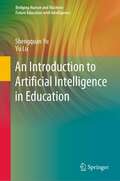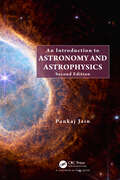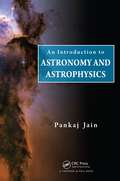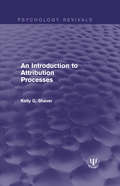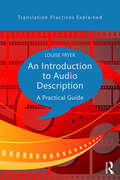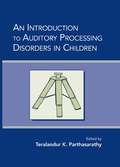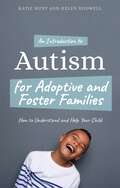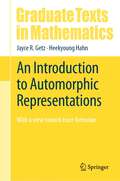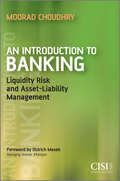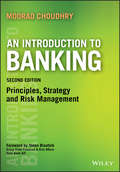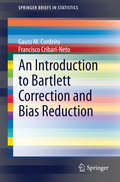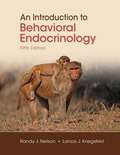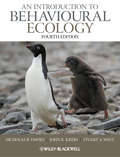- Table View
- List View
An Introduction to Artificial Intelligence in Education (Bridging Human and Machine: Future Education with Intelligence)
by Shengquan Yu Yu LuThis book systematically reviews a broad range of cases in education that utilize cutting-edge AI technologies. Furthermore, it introduces readers to the latest findings on the scope of AI in education, so as to inspire researchers from non-technological fields (e.g. education, psychology and neuroscience) to solve education problems using the latest AI techniques. It also showcases a number of established AI systems and products that have been employed for education. Lastly, the book discusses how AI can offer an enabling technology for critical aspects of education, typically including the learner, content, strategy, tools and environment, and what breakthroughs and advances the future holds.The book provides an essential resource for researchers, students and industrial practitioners interested and engaged in the fields of AI and education. It also offers a convenient handbook for non-professional readers who need a primer on AI in education, and who want to gain a deeper understanding of emerging trends in this domain.
An Introduction to Artificial Psychology: Application Fuzzy Set Theory and Deep Machine Learning in Psychological Research using R
by Peter Watson Sara Saljoughi Hojjatollah Farahani Marija Blagojević Parviz Azadfallah Forough EsrafilianArtificial Psychology (AP) is a highly multidisciplinary field of study in psychology. AP tries to solve problems which occur when psychologists do research and need a robust analysis method. Conventional statistical approaches have deep rooted limitations. These approaches are excellent on paper but often fail to model the real world. Mind researchers have been trying to overcome this by simplifying the models being studied. This stance has not received much practical attention recently. Promoting and improving artificial intelligence helps mind researchers to find a holistic model of mental models. This development achieves this goal by using multiple perspectives and multiple data sets together with interactive, and realistic models. In this book, the methodology of approximate inference in psychological research from a theoretical and practical perspective has been considered. Quantitative variable-oriented methodology and qualitative case-oriented methods are both used to explain the set-oriented methodology and this book combines the precision of quantitative methods with information from qualitative methods. This is a book that many researchers can use to expand and deepen their psychological research and is a book which can be useful to postgraduate students. The reader does not need an in-depth knowledge of mathematics or statistics because statistical and mathematical intuitions are key here and they will be learned through practice. What is important is to understand and use the new application of the methods for finding new, dynamic and realistic interpretations. This book incorporates theoretical fuzzy inference and deep machine learning algorithms in practice. This is the kind of book that we wished we had had when we were students. This book covers at least some of the most important issues in mind research including uncertainty, fuzziness, continuity, complexity and high dimensionality which are inherent to mind data. These are elements of artificial psychology. This book implements models using R software.
An Introduction to Astrobiology
by David A. Rothery Iain Gilmour Mark A. SephtonHow did life on Earth begin? How common is it elsewhere in the Universe? Written and edited by planetary scientists and astrobiologists, this undergraduate-level textbook provides an introduction to the origin and nature of life, the habitable environments in our solar system and the techniques most successfully used for discovery and characterisation of exoplanets. This third edition has been thoroughly revised to embrace the latest developments in this field. Updated topics include the origins of water on Earth, the exploration of habitable environments on Mars, Europa and Enceladus, and the burgeoning discoveries in exoplanetary systems. Ideal for introductory courses on the subject, the textbook is also well-suited for self-study. It highlights important concepts and techniques in boxed summaries, with questions and exercises throughout the text, with full solutions provided. Online resources, hosted at www.cambridge.org/features/planets, include selected figures from the book, self-assessment questions and sample tutor assignments.
An Introduction to Astronomy and Astrophysics
by Pankaj JainAstronomy is the field of science devoted to the study of astronomical objects, such as stars, galaxies, and nebulae. Astronomers have gathered a wealth of knowledge about the universe through hundreds of years of painstaking observations. These observations are interpreted by the use of physical and chemical laws familiar to mankind. These interpretations supply information about the nature of these astronomical objects, allowing for the deduction of their surface and interior conditions. The science associated with these interpretations is called astrophysics.An Introduction to Astronomy and Astrophysics offers a comprehensive introduction to astronomy and astrophysics, complete with illustrative examples and illuminating homework problems. Requiring a familiarity with basic physics and mathematics, this undergraduate-level textbook: Addresses key physics concepts relevant to stellar observations, including radiation, electromagnetic spectrum, photometry, continuous and discrete spectrum, and spectral lines. Describes instruments used for astronomical observations as well as how the radiation received is characterized and interpreted to determine the properties of stars. Examines the structure of stars, the basic equations that explain stars in equilibrium, and the fusion reactions occurring in stellar cores. Discusses the evolution of stars, the solar system, the dynamics of galaxies, and the fundamentals of modern cosmology. Explores the universe at high redshifts, where it is dominated by objects such as active galaxies. An Introduction to Astronomy and Astrophysics teaches students how to interpret the night sky, providing them with a critical understanding of the stars and sun, solar system, extrasolar planets, stars, and galaxies.The book is thoroughly revised to make it an essential textbook for students. The Second edition introduces the following changes: New solutions are provided at the end of all the chapters. The number of problems has increased. Major chapters have been considerably revised and new developments in this field have been introduced.
An Introduction to Astronomy and Astrophysics
by Pankaj JainAstronomy is the field of science devoted to the study of astronomical objects, such as stars, galaxies, and nebulae. Astronomers have gathered a wealth of knowledge about the universe through hundreds of years of painstaking observations. These observations are interpreted by the use of physical and chemical laws familiar to mankind. These interpr
An Introduction to Atmospheric Physics
by David G. AndrewsAn Introduction to Atmospheric Physics presents a broad coverage of atmospheric physics, including atmospheric thermodynamics, radiative transfer, atmospheric fluid dynamics and elementary atmospheric chemistry. Armed with an understanding of these topics, the interested student will be able to grasp the essential physics behind issues of current concern, such as the enhanced greenhouse effect and associated questions of climate change, and the Antarctic ozone hole and global ozone depletion, as well as more familiar processes such as the formation of raindrops and the development of weather systems. This book is intended as an introductory text for intermediate to advanced undergraduates studying atmospheric physics as part of physics, meteorology or environmental science courses. It will also be useful for graduate students studying atmospheric physics for the first time and for students of applied mathematics, physical chemistry and engineering who have an interest in the atmosphere.
An Introduction to Atmospheric Thermodynamics
by Anastasios A. TsonisThis is a self-contained, concise, rigorous book introducing the reader to the basics of atmospheric thermodynamics, and the author is a highly respected researcher in this field. This new edition has been brought completely up to date and reorganized to improve the quality and flow of the material. Each chapter contains worked examples and student exercises, making this an ideal text for short undergraduate courses taken as part of an atmospheric science, meteorology, physics or natural science program. Solutions available to lecturers.
An Introduction to Attribution Processes (Psychology Revivals)
by Kelly G. ShaverWhy do people act the way they do? How do their desires and fears become known to us? When are our opinions of others correct, and when are they likely to be mistaken? These are questions which attribution theory tries to answer. Originally published in 1975, this title provides an informal introduction to the field of attribution, with the theoretical principles and issues illustrated in everyday examples. The origins of current attribution theory are outlined, and models of the inference process are examined. The intellectual debt owed to social psychology by the attribution theory is acknowledged, and an exploration of the interpersonal and social consequences of attribution is included.
An Introduction to Audio Content Analysis: Music Information Retrieval Tasks and Applications
by Alexander LerchAn Introduction to Audio Content Analysis Enables readers to understand the algorithmic analysis of musical audio signals with AI-driven approaches An Introduction to Audio Content Analysis serves as a comprehensive guide on audio content analysis explaining how signal processing and machine learning approaches can be utilized for the extraction of musical content from audio. It gives readers the algorithmic understanding to teach a computer to interpret music signals and thus allows for the design of tools for interacting with music. The work ties together topics from audio signal processing and machine learning, showing how to use audio content analysis to pick up musical characteristics automatically. A multitude of audio content analysis tasks related to the extraction of tonal, temporal, timbral, and intensity-related characteristics of the music signal are presented. Each task is introduced from both a musical and a technical perspective, detailing the algorithmic approach as well as providing practical guidance on implementation details and evaluation. To aid in reader comprehension, each task description begins with a short introduction to the most important musical and perceptual characteristics of the covered topic, followed by a detailed algorithmic model and its evaluation, and concluded with questions and exercises. For the interested reader, updated supplemental materials are provided via an accompanying website. Written by a well-known expert in the music industry, sample topics covered in Introduction to Audio Content Analysis include: Digital audio signals and their representation, common time-frequency transforms, audio features Pitch and fundamental frequency detection, key and chord Representation of dynamics in music and intensity-related features Beat histograms, onset and tempo detection, beat histograms, and detection of structure in music, and sequence alignment Audio fingerprinting, musical genre, mood, and instrument classification An invaluable guide for newcomers to audio signal processing and industry experts alike, An Introduction to Audio Content Analysis covers a wide range of introductory topics pertaining to music information retrieval and machine listening, allowing students and researchers to quickly gain core holistic knowledge in audio analysis and dig deeper into specific aspects of the field with the help of a large amount of references.
An Introduction to Audio Description: A practical guide (Translation Practices Explained)
by Louise FryerAn Introduction to Audio Description is the first comprehensive, user-friendly student guide to the theory and practice of audio description, or media narration, providing readers with the skills needed for the effective translation of images into words for the blind and partially-sighted. A wide range of examples – from film to multimedia events and touch tours in theatre, along with comments throughout from audio description users, serve to illustrate the following key themes: the history of audio description the audience the legal background how to write, prepare and deliver a script. Covering the key genres of audio description and supplemented with exercises and discussion points throughout, this is the essential textbook for all students and translators involved in the practice of audio description. Accompanying film clips are also available at: https://www.routledge.com/products/9781138848177 and on the Routledge Translation Studies Portal: http://cw.routledge.com/textbooks/translationstudies/.
An Introduction to Auditory Processing Disorders in Children
by Teralandur K. ParthasarathyAuditory processing in children (APD) comprises an increasingly important clinical area within the broad field of communication disorders. This new textbook presents the major advances in the assessment and management of APD. The chapter authors, highly regarded clinicians and researchers from diverse professional groups, contribute an impressive breadth of knowledge to explain and demystify APD. This text will be useful to students of speech language pathology and audiology, as well as professionals in those fields.
An Introduction to Australian Public Policy
by Sarah Maddison Richard DennissThe public policy arena is a complex framework of actors, politics and instruments. An Introduction to Australian Public Policy Second Edition examines the broad range of models, influences and players that shape the development of public policy in Australia, and equips students with a working knowledge of both the theoretical underpinnings and real-world challenges of the field. Fully revised and updated, the new edition addresses the diverse approaches to policy formulation required by different practitioners and institutions. Accessible and engaging, this edition includes: a new chapter on policy evaluation; practical exercises on how to write policy briefs and media releases and eleven new, concise case studies from Australia's top public policy practitioners. The book is accompanied by a companion website which contains chapter summaries and a glossary. Widely regarded as the best introduction to Australian public policy available, the book is an essential resource for undergraduate students of politics and policy workers.
An Introduction to Australian Public Policy
by Sarah Maddison Richard DennissAn Introduction to Australian Public Policy: Theory and Practice is the first book to comprehensively address both the theoretical and practical aspects of policy making in Australia. Written in an accessible style, this text is designed to introduce students to the real world challenges and skills involved in working in a range of policy roles. Drawing on their own experiences, the authors ground public policy theory in a number of key controversies to illustrate the contestable nature of the policy process. Each chapter features case studies that outline contemporary policy issues, such as the deregulation of the financial system, 'Knowledge Nation', paid maternity leave, and the Northern Territory intervention. Including practical exercises on how to write policy briefs and media releases, this book is essential reading for anyone who needs to know how public policy is developed in Australia.
An Introduction to Autism for Adoptive and Foster Families: How to Understand and Help Your Child
by Helen Rodwell Katie HuntWritten for busy foster carers and adoptive parents, this book provides a concise introduction to Autism Spectrum Disorder (ASD), and how to support a child with a diagnosis. It emphasises the common strengths children with ASD have, as well as offering strategies for any behavioural issues that are likely to arise, highlighting how these can be exacerbated by the care system and adoption process.The first part of the book looks at the different aspects of autism and the challenges it can pose for children and parents, providing strategies for managing difficulties at home and at school, using social stories, and reducing sensory input in a child's environment. The second part looks at issues that arise for fostered or adopted children, including placement transitions, contact, and explaining the past. It concludes with helping parents to think about self-care.
An Introduction to Automorphic Representations: With a view toward trace formulae (Graduate Texts in Mathematics #300)
by Jayce R. Getz Heekyoung HahnThe goal of this textbook is to introduce and study automorphic representations, objects at the very core of the Langlands Program. It is designed for use as a primary text for either a semester or a year-long course, for the independent study of advanced topics, or as a reference for researchers. The reader is taken from the beginnings of the subject to the forefront of contemporary research. The journey provides an accessible gateway to one of the most fundamental areas of modern mathematics, with deep connections to arithmetic geometry, representation theory, harmonic analysis, and mathematical physics.The first part of the text is dedicated to developing the notion of automorphic representations. Next, it states a rough version of the Langlands functoriality conjecture, motivated by the description of unramified admissible representations of reductive groups over nonarchimedean local fields. The next chapters develop the theory necessary to make the Langlands functoriality conjecture precise. Thus supercuspidal representations are defined locally, cuspidal representations and Eisenstein series are defined globally, and Rankin-Selberg L-functions are defined to give a link between the global and local settings. This preparation complete, the global Langlands functoriality conjectures are stated and known cases are discussed.This is followed by a treatment of distinguished representations in global and local settings. The link between distinguished representations and geometry is explained in a chapter on the cohomology of locally symmetric spaces (in particular, Shimura varieties). The trace formula, an immensely powerful tool in the Langlands Program, is discussed in the final chapters of the book. Simple versions of the general relative trace formulae are treated for the first time in a textbook, and a wealth of related material on algebraic group actions is included. Outlines for several possible courses are provided in the Preface.
An Introduction to Banking: Liquidity Risk and Asset-Liability Management (Securities Institute #30)
by Moorad Choudhry Oldrich Maseks of the core principles of good banking practice.
An Introduction to Banking: Principles, Strategy and Risk Management (Securities Institute #30)
by Moorad ChoudhryA practical primer to the modern banking operation Introduction to Banking, Second Edition is a comprehensive and jargon-free guide to the banking operation. Written at the foundational level, this book provides a broad overview of banking to give you an all-around understanding that allows you to put your specialty work into context within the larger picture of your organization. With a specific focus on risk components, this second edition covers all key elements with new chapters on reputational risk, credit risk, stress testing and customer service, including an updated chapter on sustainability. Practical material includes important topics such as the yield curve, trading and hedging, asset liability management, loan origination, product marketing, reputational risk and regulatory capital. This book gives you the context you need to understand how modern banks are run, and the key points operation at all levels. Learn the critical elements of a well-structured banking operation Examine the risk components inherent in banking Understand operational topics including sustainability and stress testing Explore service-end areas including product marketing and customer service Banks continue to be the heart of the modern economy, despite the global financial crisis —they have however become more complex. Multiple layers and a myriad of functions contribute to the running of today's banks, and it's critical for new and aspiring bankers to understand the full breadth of the operation and where their work fits in. Introduction to Banking, Second Edition provides an accessible yet complete primer, with emphasis on the areas that have become central to sustainable banking operation.
An Introduction to Bartlett Correction and Bias Reduction (SpringerBriefs in Statistics)
by Gauss M. Cordeiro Francisco Cribari-NetoThis book presents a concise introduction to Bartlett and Bartlett-type corrections of statistical tests and bias correction of point estimators. The underlying idea behind both groups of corrections is to obtain higher accuracy in small samples. While the main focus is on corrections that can be analytically derived, the authors also present alternative strategies for improving estimators and tests based on bootstrap, a data resampling technique and discuss concrete applications to several important statistical models.
An Introduction to Bayesian Inference, Methods and Computation
by Nick HeardThese lecture notes provide a rapid, accessible introduction to Bayesian statistical methods. The course covers the fundamental philosophy and principles of Bayesian inference, including the reasoning behind the prior/likelihood model construction synonymous with Bayesian methods, through to advanced topics such as nonparametrics, Gaussian processes and latent factor models. These advanced modelling techniques can easily be applied using computer code samples written in Python and Stan which are integrated into the main text. Importantly, the reader will learn methods for assessing model fit, and to choose between rival modelling approaches.
An Introduction to Behavior Analysis
by Derek D. Reed Florence D. DiGennaro Reed Gregory J. MaddenExplore a fascinating introductory treatment of the principles of behavior analysis written by three leading voices in the field An Introduction to Behavior Analysis delivers an engaging and comprehensive introduction to the concepts and applications of behavior analysis for students of behavior analysis. Written from the ground up to capture and hold student interest, the book keeps its focus on practical issues. This book offers readers sound analyses of Pavlovian and operant learning, reinforcement and punishment, motivation and stimulus control, language and rule-following, decision-making and clinical behvior analysis. With fully up to date empirical research references and theoretical content, An Introduction to Behavior Analysis thoroughly justifies every principle it describes with empirical support and explicitly points out where more data are required. The text encourages students to analyze their own experiences and some foundational findings in the field in a way that minimizes jargon and maximizes engagement. Readers will also benefit from the inclusion of: A clear articulation and defense of the philosophical assumptions and overarching goals of behavior analysis. A thorough description of objective data collection, experimental methods, and data analysis in the context of psychology An exploration of the core principles of behavior analysis, presented at a level comprehensible to an introductory audience A broad array of principles that cover issues as varied as language, substance-use disorders, and common psychological disorders Perfect for students taking their first course in behavior analysis or behavior modification, An Introduction to Behavior Analysis will also earn a place in the libraries of students pursuing certification through the Behavior Analysis Certification Board or taking courses in the applied psychological sciences.
An Introduction to Behavioral Endocrinology (Sinauer)
by Randy J. Nelson Lance J. KriegsfeldThe market-leading text, An Introduction to Behavioral Endocrinology, Sixth Edition provides an updated, integrated presentation of the study of hormone-behavior-brain interactions. Maintaining a comparative approach, the text explores the endocrine mechanisms that have evolved in both human and nonhuman animals to solve common problems in survival and reproduction. <p><p>The text describes interactions among hormones, brain, and behavior from a historical perspective, emphasizing connections among key theories and tracing the emergence of important hypotheses. The book is organized around the conceptual theme that hormones affect behavior by influencing one or more of three "components" of behaving animals--input mechanisms (such as sensory or perceptual processes), the central processing mechanisms of the nervous system (either directly, or by affecting its development or structure), and output mechanisms (such as effectors or peripheral structures). Despite increased coverage of molecular and cellular approaches, the book strives for accessibility for non-biological science students.
An Introduction to Behavioral Endocrinology, Fifth Edition
by Randy J. Nelson Lance J. KriegsfeldAn Introduction to Behavioral Endocrinology, Fifth Edition retains all of the features of the bestselling prior editions, and provides an updated, integrated presentation of the study of hormone-behavior-brain interactions.
An Introduction to Behavioral Finance and Asset Management: A Guide for Students and Professionals in Wealth Management
by Yannick CoulonThis book introduces readers to behavioral finance applied to wealth management. It explains essential behavioral biases and their damaging consequences including financial bubbles, and Prospect Theory. Additionally, it establishes fundamental rules for improving the structuring and protection of wealth. Despite its practical and didactic aspects, the book is accessible without sacrificing the depth of the subject. Aimed at students, asset managers, financial advisors, and investors, the book explores the behavioral approach on financial decisions and examines the psychology around investor behavior.
An Introduction to Behavioural Ecology
by Nicholas B. Davies Stuart A. West John R. KrebsAdditional resources for this book can be found at: www.wiley.com/go/davies/behaviouralecologyThis textbook helped to define the field of Behavioural Ecology. In this fourth edition the text has been completely revised, with new chapters and many new illustrations and full colour photographs. The theme, once again, is the influence of natural selection on behaviour - an animal's struggle to survive and reproduce by exploiting and competing for resources, avoiding predators, selecting mates and caring for offspring, - and how animal societies reflect both cooperation and conflict among individuals.Stuart A. West has joined as a co-author bringing his own perspectives and work on microbial systems into the book.Written in the same engaging and lucid style as the previous editions, the authors explain the latest theoretical ideas using examples from micro-organisms, invertebrates and vertebrates. There are boxed sections for some topics and marginal notes help guide the reader. The book is essential reading for students of behavioural ecology, animal behaviour and evolutionary biology.Key Features:Long-awaited new edition of a field-defining textbookNew chapters, illustrations and colour photographsNew co-authorFocuses on the influence of natural selection on behavior, and how animal societies reflect both cooperation and conflict among individuals"The long-awaited update to a classic in this field is now here, presenting new directions in thinking and addressing burning questions. Richly informed by progress in many other disciplines, such as sensory physiology, genetics and evolutionary theory, it marks the emergence of behavioural ecology as a fully fledged discipline..... This is a marvellous book, written in a lucid style. A must-read for those in the field, it is also a cornucopia of new thinking for anyone interested in evolution and behaviour."Manfred Milinski, Nature, 2012
An Introduction to Behavioural Ecology
by Nicholas B. Davies Stuart A. West John R. KrebsThis textbook helped to define the field of Behavioural Ecology. In this fourth edition the text has been completely revised, with new chapters and many new illustrations and full colour photographs. The theme, once again, is the influence of natural selection on behaviour – an animal's struggle to survive and reproduce by exploiting and competing for resources, avoiding predators, selecting mates and caring for offspring, – and how animal societies reflect both cooperation and conflict among individuals. Stuart A. West has joined as a co-author bringing his own perspectives and work on microbial systems into the book. Written in the same engaging and lucid style as the previous editions, the authors explain the latest theoretical ideas using examples from micro-organisms, invertebrates and vertebrates. There are boxed sections for some topics and marginal notes help guide the reader. The book is essential reading for students of behavioural ecology, animal behaviour and evolutionary biology. Key Features: Long-awaited new edition of a field-defining textbook New chapters, illustrations and colour photographs New co-author Focuses on the influence of natural selection on behavior, and how animal societies reflect both cooperation and conflict among individuals “The long-awaited update to a classic in this field is now here, presenting new directions in thinking and addressing burning questions. Richly informed by progress in many other disciplines, such as sensory physiology, genetics and evolutionary theory, it marks the emergence of behavioural ecology as a fully fledged discipline….. This is a marvellous book, written in a lucid style. A must-read for those in the field, it is also a cornucopia of new thinking for anyone interested in evolution and behaviour.” Manfred Milinski, Nature, 2012
